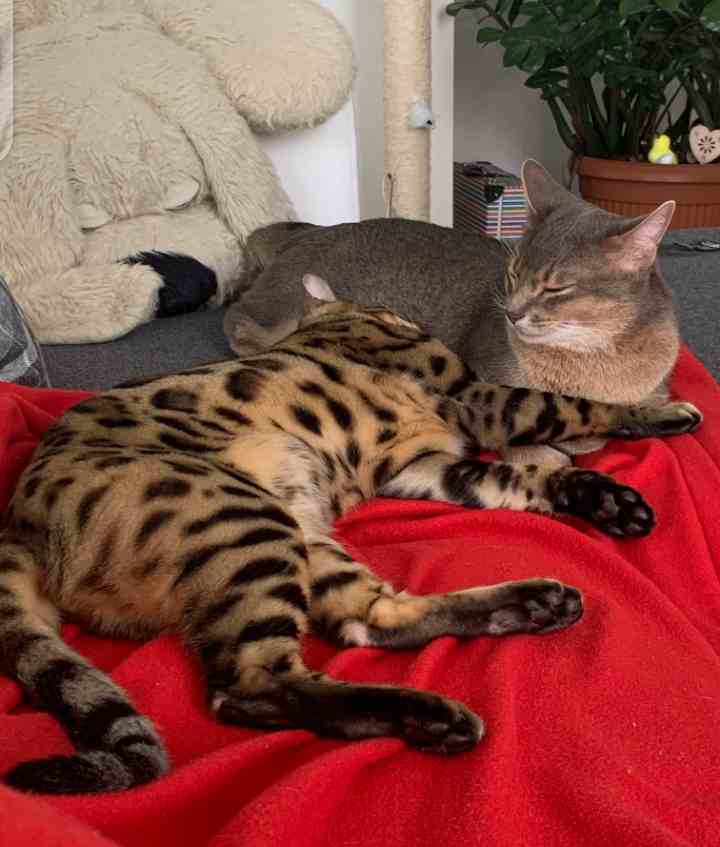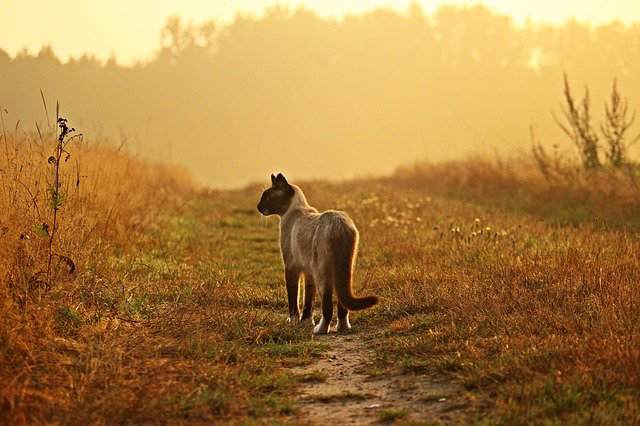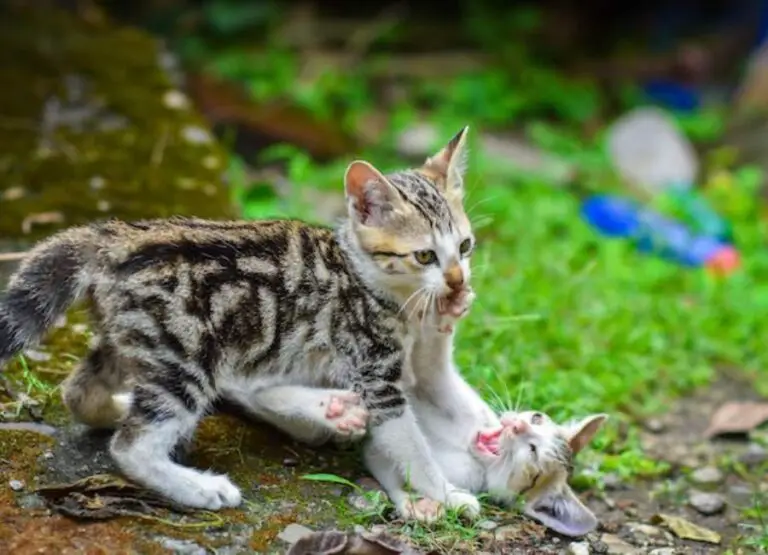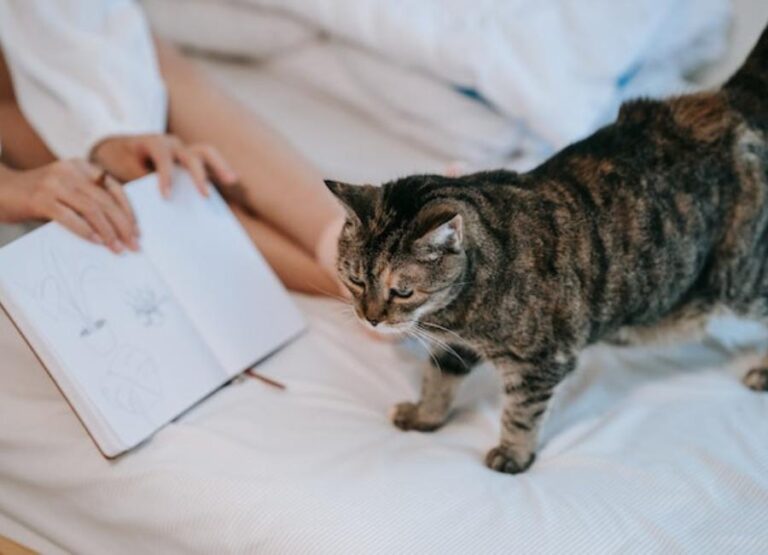Do Bengal Cats Get Along With Other Cats: 100 Owners Case Study

As a cat lover, I always get asked do Bengal cats get along with other cats a lot, as I took 2 weeks of my time to contact 300 Bengal cat owners.
So, over 90% of what you get in this post is a result of my outreach to 300 real owners Bengal with less than 10% from other sites.
Before we continue I must point out that not all the 300 owners responded within the time limit, therefore, the data output excluded them.
You have to be very careful when introducing a Bengal cat to other breeds since they have been cases of Bengal cat attacking other cats.
So, Do Bengal Cats Get Along With Other Cats?
Bengal cats are a very social breed of cat that gets along with other cats when properly trained and socialized, due to their territorial nature they do not accept other cats if they are not properly introduced to other cats.
Bengal cats are naturally lively, active, and territorial, and will not tolerate other cats intruding on their area.
However, if properly socialized, Bengal cats will accept and show affection to other cats living in the same house.
Bengal cats can grow very big and it is not advisable to introduce a Bengal cat between 4 to 7 years.
Bengal cats have lots of pros and cons you should consider before getting one, don’t get a Bengal cat until you see this article.

Bengal cat owners case study
After I contacted 300 owners of Bengal cats from different forums, Facebook groups, and Reddit groups, here is the breakdown of respondents.

30 owners didn’t respond, while 150 said they have only one single Bengal cat, 20 of the owners said they have a Bengal cat living with a dog.
100 owners said they have a Bengal with other breeds of cats, which means I continued the study with the 100 persons.
I have also written a topic on the question do Bengal cats get along with dogs, so if you want to get a dog for your Bengal check it out to see the best dog to get.
That been said, let’s continue with the data I got from the remaining 100 persons, which I have presented in the image below.

Since these 100 persons said they had other cats living with their Bengal cat, I wanted to know the breed of cats they have.
So I asked them to pick the breed of cats they have in the list I made from my research, so they responded.
40 persons out of the 100 Bengal cat owners said they have a second Bengal cat, 23 of them said they have a Siamese cat. You can check out the 20 pros and cons of having a Siamese cat.
17 owners said they have an Abyssinian cat, 10 owners said they have a Siberian cat while 10 said they have a Persian cat, also check out the 20 pros and cons of having a Persian cat.
This now raised a question which breed of cats is better to adopt or get if you have a Bengal cat?
Best breeds of cats that gets along with Bengal cats
Here is the list of the best breeds of cats to buy or adopt if you have a Bengal cat:
- Bengal cat
- Siamese cat
- Abyssinian cat
- Persian cat
- Siberian cat
Of course, this list was made from my research and interaction with 100 cats owners.
What is the best way to introduce another cat to a Bengal cat?
Let’s look at the best way to introduce other breeds of cats to a Bengal, you have to be careful with the process.
Bengal cats are very territorial and love their space such that they may not want to accept other cats.
This is why you need to socialize your Bengal from the kitten stages, that been said let’s look at some things you need before getting a second cat:
- Another cat bed
- Second feeding can or plate
- More toys
- A crate
- Second water can
- A second room or a basement
- Another litter box
How to introduce other cats to a resident Bengal cat:
Get ready for the new cat’s arrival
To prepare for bringing your new cat home, prepare a separate room or your basement.
Here are a few things to consider:
- Sweeping all corners to ensure they are clean.
- In the same room, plan a modest hiding spot for your cat.
- Placing the litter box in an easily accessible location.
- Clean water is being placed for the new kitty.
- Keep a cat bed near the hiding spot you set up.
- Check to see if the room can be locked.
After you’ve completed all of the above steps, go acquire your new cat and a carrier that suits the cat’s size.
Welcoming the new cat
To avoid a surprise assault, you must restrict your resident Bengal cat’s bounds before bringing the new cat down from the car or whatever mode of transportation you utilized.
Make sure your Bengal cat does not have access to the new cat, regardless of how well you believe you have socialized your Bengal cat.
Bengal cats are excellent hunters with innate hunting instincts, and they will attack to defend their territory.
Allow the new cat to explore the new house by putting him or her in his or her own room.
Allow him or her time to adjust to their new surroundings, and attempt to visit 3–4 times each day to observe how they are doing.
Make sure he or she has everything they need, and once they’ve gotten acclimated to their new home, get ready for a formal introduction.
How will you know whether the new cat is ready to be introduced?
As soon as you go in, he or she gets bold and quits hiding.
Allow him or her to move at his or her own pace during this procedure.
Take your time since meeting your Bengal cat will require confidence and courage on his or her part.
Introducing the new cat to the resident Bengal cat
Before making any introductions, make sure you’ve exhausted the resident Bengal cat’s energy.
It’s easy; simply play fetch with your Bengal cat for 5 to 10 minutes.
Once your Bengal is out and relaxed, gently introduce the new cat into the house, keeping an eye out for responses.
This introduction will not take a certain number of days; it may take longer than planned, depending on the personalities of the cats.
Allow your Bengal cat to investigate the new cat after bringing it near to the Bengal cat, but be cautious of unexpected assaults.
To avoid a hazardous attack, keep the Bengal cat on a leash if at all feasible.
Give both cats goodies and hug them with separate hands at the same time.
Allow some time for the Bengal cat to explore the new cat before returning the new cat to his or her chamber.
Second meeting of both cats
Put your Bengal cat in a crate or on a leash the next day and take the new cat for a walk around the house, allowing him or her to investigate the entire structure.
Take him or her to explore your Bengal cat after he or she is finished, but this time remove the Bengal cat from his or her box.
Give both cats treats and give a new interactive toy, such as an electric fish, for them to investigate.
Because everything is new, the new cat may not attack depending on its personality, so pay extra attention to your Bengal cat.
Return the new cat to his or her chamber once they’ve finished.
Take your Bengal cat to visit the new cat room
Take your Bengal cat to see the new cat in his or her room this time. Before leaving, provide goodies and cuddles.
Allow both to play with each other and supply toys, as well as occasional gifts and participation in the game.
Take the Bengal cat away after the game.
You should have found out if the Bengal cat is ready to accept the new cat at this point.
Hello and welcome to our world
For the first several weeks, keep litter boxes, food plates, and water cans separate.
Both cats will become great friends and watch out for each other over time.
Take your time and don’t rush through the procedure.
The important message here is that, despite extensive socialization, your Bengal cat may have difficulty accepting another cat who does not live with him or her.
Bengal cats, on the other hand, require the assistance of other cats to overcome some of their frequent behavioral issues.
Read more about 12 Bengal Cat Behavior Problems.
One of the finest things you can do for your Bengal cat is to get a second cat when it is still a kitten.
So, let’s have a look at why your Bengal cat requires the company of other cats.
Reasons why your Bengal cat need another cat
Here are some common reasons why your Bengal cat need other cats;
Getting another cat can help to solve separation anxiety issues
When you leave your Bengal cat at home or unattended for lengthy periods of time, it develops separation anxiety.
Separation anxiety can be lessened or eliminated with the presence of a companion cat and engaging toys.
This is the most important reason to obtain another cat for your Bengal cat in order to avoid unwanted habits.
However, it is ideal to introduce both cats as kittens so that they can grow up together and become great friends.
Getting another cat will help to solve your Bengal cat depression issues
Bengal cats are rarely sad when there is another cat to keep them occupied all day.
Most negative behaviors in cats are caused by sadness, and separation anxiety will almost certainly lead to needless melancholy.
As a result, having a second cat in your Bengal cat’s life is crucial. Depression is one of the reasons why Bengal cats can become aggressive.
Getting a second cat help your Bengal cat to become a better family cat
Your Bengal cat’s bonding will not only help them become more sociable, but it will also help them build their bonds with other family members.
The more time you and your second cat spend with your Bengal cat, the more affection the Bengal have for all of your family members.
Are Bengal cats good house pets? Find out more on my other article about the Bengal cat.
Getting a second cat can help to assist them in getting more exercise
One thing to keep in mind with Bengal cats is that they are highly lively and active, and they require stimulation to prevent being sad.
If you buy a second cat, it will go a long way toward ensuring that your Bengal cat gets some exercise while you are gone.
Bengal cats enjoy playing and running about, so having a second cat will make life simpler for both you and your cat.
Check some health challenges associated with Bengal cats, some of which can be triggered by a lack of proper exercise.
Getting a second cat for your Bengal cat will help solve loneliness issues
This is why Bengal cats become sad, aggressive, and engage in inappropriate behavior.
Bengal cats claw and bite fiercely when they are lonely.
Purchasing a second cat, rather than just getting toys, is one approach to solve the problem of Bengal cat loneliness.
Bengal cats, unlike Ragdoll cats, are not inherently sociable, therefore you will need to assist them to socialize with other pets.
Getting a second cat will improve your Bengal cat’s social life and make them less hostile toward other animals.
Are Bengal cats affectionate?
Yes, Bengal cats of all generations are extremely loving toward their owners and family members, but they will need to be socialized before they can accept new family members, whether they be dogs, cats, or other pets.
Bengal cats are highly lively, active, and spirited, therefore they like playing a lot.
Anyone is welcome to join the Bengals as long as you reward them or play with them.
Are Bengal cats wild?
Bengal cats are wild cats since the first generation was created by cross-breeding with Asian leopard cats, and Bengal cats are recognized for being excellent hunters.
Until the 4th generation before a Bengal cat is considered a purebred Bengal, read more about the generation of Bengal cats here.
Because of their wildlife instincts, people always ask if you can allow them to go outside.
Check this article on can Bengal cats go outside you will also see reasons you shouldn’t let them go outside without your supervision.
Are Bengal cats aggressive with other cats?
Bengal cats are fiercely territorial, and they are frequently hostile against strangers or visitors. However, if properly trained and socialized, they get along with other cats that share their home.
Are Bengal cats good house pets?
Bengal cats make excellent home pets because they get along well with other cats, dogs, and pets and exhibit a high level of devotion for their owners and family members. They also keep rats and scary creatures out of their house.
Am Outta!!!


![Why Is My Cat So Aggressive Lately [See 9 Reasons] Why Is My Cat So Aggressive Lately](https://petcreeks.com/wp-content/uploads/2023/10/cat-7201639_640.jpg)



